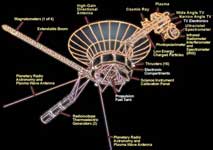Cellphone Radiation Levels?
Of course when I use a cellphone, I use an earplug with a long cord, and I hold the phone as far from my body as possible. I only take the phone with me when I have to be near a phone.
Voyager 2: Talking Back
Voyager 2 was launched
by NASA and JPL in 1977. Its mission then was to study Saturn, and to engage flybys of the outer gas planets (Jupiter, Uranus and Neptune) along the way. The planets were aligned in a fashion that only happens in a 176 year cycle. Voyager 2 accomplished its mission flawlessly, sending back data and thousands of images. It then continued merrily on its way, headed out past the solar system, going where, well, no one we know has ever been before.Now, 33 years later, Voyager 2 is still headed out, about to leave the solar system. It's about 8.6 billion miles away now, and passing through the heliosphere, the magnetic bubble generated by the sun that surrounds our solar system. But in May, Voyager 2 inexplicably stopped talking.
Brits & Solar Storm Effects
For months now the world has been told to expect bad space weather "that could generate unexpected currents in electricity distribution grids, that could lead to blackouts and damage to valuable infrastructure, with potentially high cost to the global economy."
Last week, the US media reported NASA's warning of a possible once in a generation space storm that could zonk out our electricity and electronics. This morning, I saw the British ITN news video, reporting the NASA warning, this warning said that "Britain could face widespread power blackouts after the earth is hit by a once in a generation space storm!"
Those Bad Solar Storms
CBS News reported today that solar storms may knock out our power grids, satellites, cell phone signals, and that we should take note and be prepared. NASA says the sun is going through a period of increased solar activity, creating intense sun storms, that could take down our technology. Take down? Put it out of commission. Scientists are working on a way to protect our electronic devices. See video.
NASA Eye Candy
One of the things of the many that NASA does well, and perhaps it is one of the most important things that NASA does, is to provide us earthbound land lubbers beautiful pictures, images and video of outer space, of the sights around our world, and of the sights around worlds and stars beyond ours. The pictures are better than science fiction, because they are real, and often times they are much better than what we can imagine.
This morning , Sunday, May 16th, the Space shuttle Atlantis, on its final voyage, arrived and docked, at the International Space Station. NASA provided the video feed. See the video. These images are just the latest eye candy from our space uncles and aunts at NASA. The Atlantis and its crew of six are expected to stay at the station for a week long visit, and feed us more of this wonderful eye candy.
Yawn, Another Shuttle Flight
Yeah. Yawn. An era will be soon coming to an end. The Space shuttle Atlantis blasted off today. Okay. Is on its way to orbit for the last time. Yeah. Atlantis and an experienced crew of six blasted off this afternoon, Friday, May 14th. Yeah. The shuttle is bound for the International Space Station. And? It should reach the orbiting complex Sunday. So what? Routine, right?
Houston, there's a problem, report finds
Yesterday, the New York Times. reports that the National Research Council, (NRC), the research arm of the National Academy of Sciences, issued a report on the National Aeronautics and Space Administration, (NASA). ten research laboratories, and concluded that the labs were merely 'marginally adequate.' The NRC reports warned that the decline of basic research at the NASA facilities, and the underfunding of research, jeopardizes the agency’s ability to study and to explore the cosmos. Joseph B. Reagan of NRC told the Times. that if NASA continued as it is "going at the current rate, in five years the research community would not be able to support NASA’s long-term goals.” Mr.
Herschel space telescope
On the net this morning , May 6, 2010, are new and interesting pictures from the Herschel space telescope. The Herschel was launched one year ago, to make it possible for scientists and for us lay people to learn more than ever about stars and about the formation of stars, so to provide a clue to what may have happened when our sun and the planets of our solar system were formed almost five-billion years ago.





